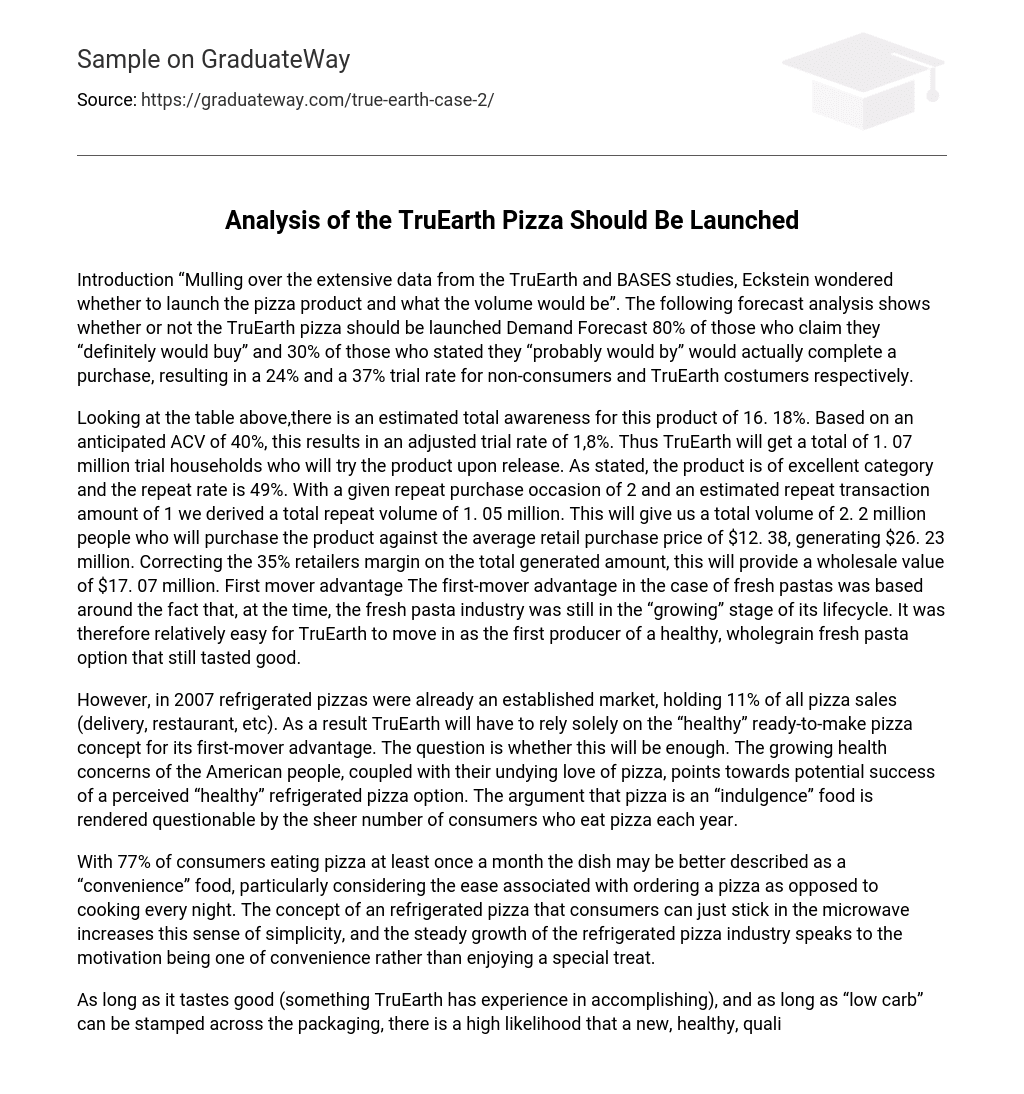Introduction “Mulling over the extensive data from the TruEarth and BASES studies, Eckstein wondered whether to launch the pizza product and what the volume would be”. The following forecast analysis shows whether or not the TruEarth pizza should be launched Demand Forecast 80% of those who claim they “definitely would buy” and 30% of those who stated they “probably would by” would actually complete a purchase, resulting in a 24% and a 37% trial rate for non-consumers and TruEarth costumers respectively.
Looking at the table above,there is an estimated total awareness for this product of 16. 18%. Based on an anticipated ACV of 40%, this results in an adjusted trial rate of 1,8%. Thus TruEarth will get a total of 1. 07 million trial households who will try the product upon release. As stated, the product is of excellent category and the repeat rate is 49%. With a given repeat purchase occasion of 2 and an estimated repeat transaction amount of 1 we derived a total repeat volume of 1. 05 million. This will give us a total volume of 2. 2 million people who will purchase the product against the average retail purchase price of $12. 38, generating $26. 23 million. Correcting the 35% retailers margin on the total generated amount, this will provide a wholesale value of $17. 07 million. First mover advantage The first-mover advantage in the case of fresh pastas was based around the fact that, at the time, the fresh pasta industry was still in the “growing” stage of its lifecycle. It was therefore relatively easy for TruEarth to move in as the first producer of a healthy, wholegrain fresh pasta option that still tasted good.
However, in 2007 refrigerated pizzas were already an established market, holding 11% of all pizza sales (delivery, restaurant, etc). As a result TruEarth will have to rely solely on the “healthy” ready-to-make pizza concept for its first-mover advantage. The question is whether this will be enough. The growing health concerns of the American people, coupled with their undying love of pizza, points towards potential success of a perceived “healthy” refrigerated pizza option. The argument that pizza is an “indulgence” food is rendered questionable by the sheer number of consumers who eat pizza each year.
With 77% of consumers eating pizza at least once a month the dish may be better described as a “convenience” food, particularly considering the ease associated with ordering a pizza as opposed to cooking every night. The concept of an refrigerated pizza that consumers can just stick in the microwave increases this sense of simplicity, and the steady growth of the refrigerated pizza industry speaks to the motivation being one of convenience rather than enjoying a special treat.
As long as it tastes good (something TruEarth has experience in accomplishing), and as long as “low carb” can be stamped across the packaging, there is a high likelihood that a new, healthy, quality-ingredient, whole-grain refrigerated pizza option will do well, even without the luxury of entering a growing market, as was the case with TruEarth’s fresh pastas. Lastly, TruEarth is enhancing the refrigerated-pizza offering by developing a “refrigerated pizza kit” that maintains the sentimental value of a true cooking experience.
Conclusion We have seen from the forecast model of the refrigerated pizza kit that the whole-grain refrigerated pizza kit could make a profit, as the $17. 07 million exceeds the minimum required wholesale value of 12 million, showing a surplus of $5. 05 million. We also have seen that TruEarth has a first mover advantage in the pizza industry by producing a healthier whole-grain refrigerated pizza kit. Therefore it would make sense for TruEarth to launch the pizza.





